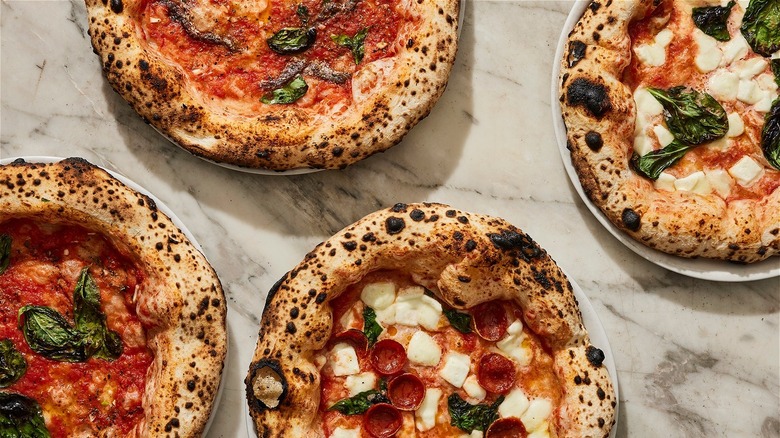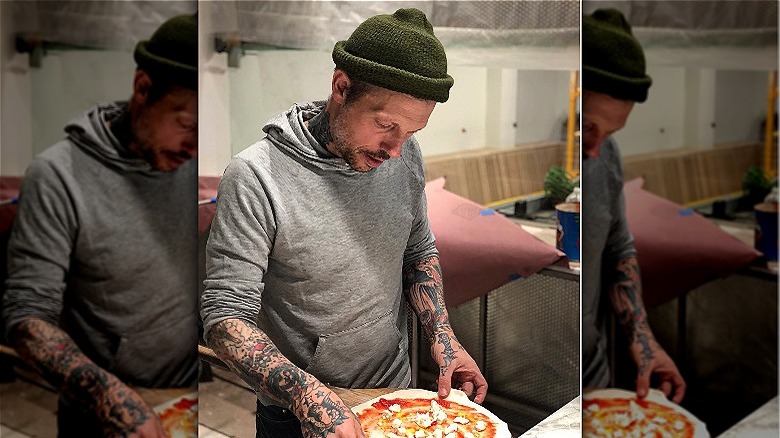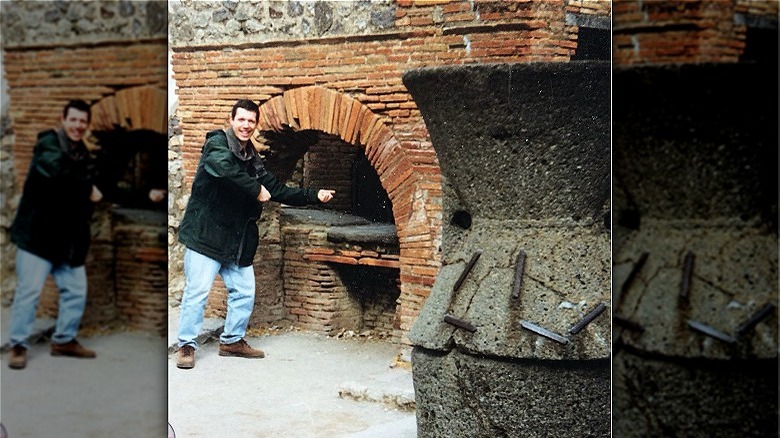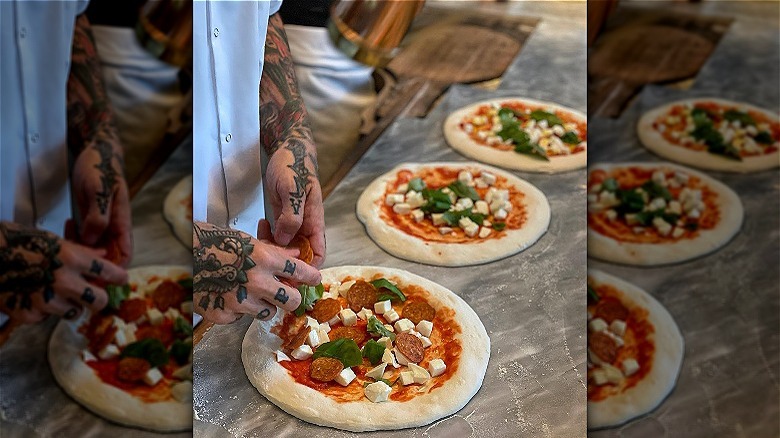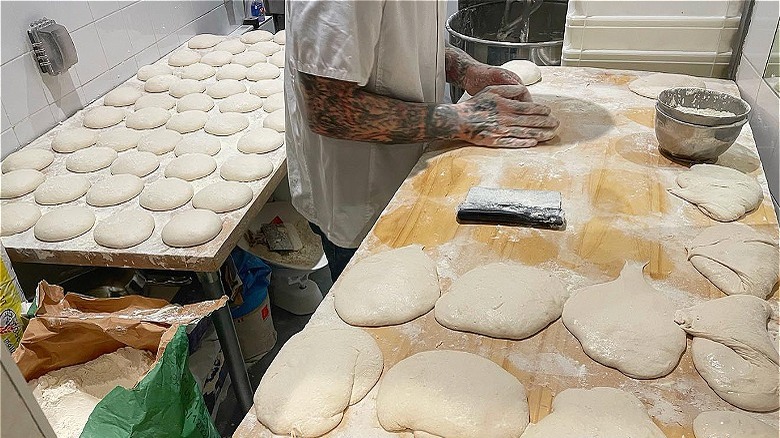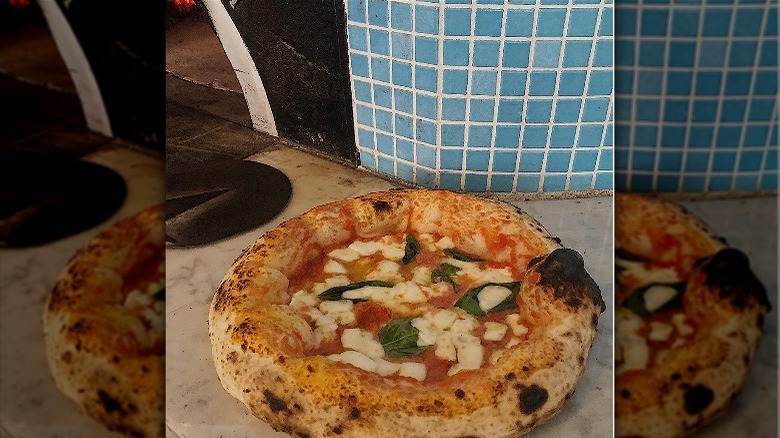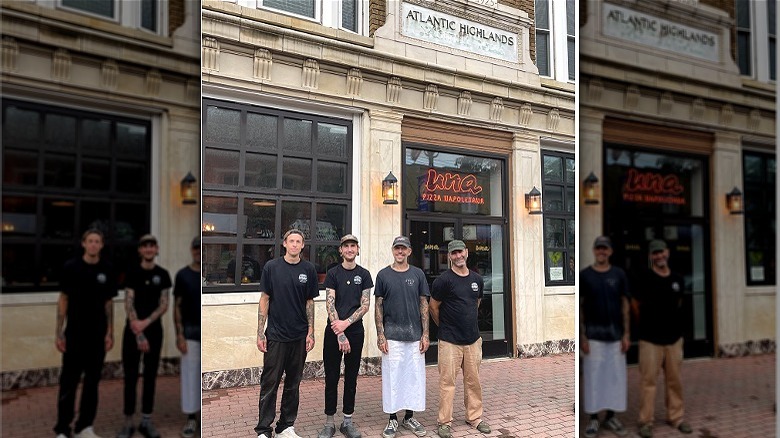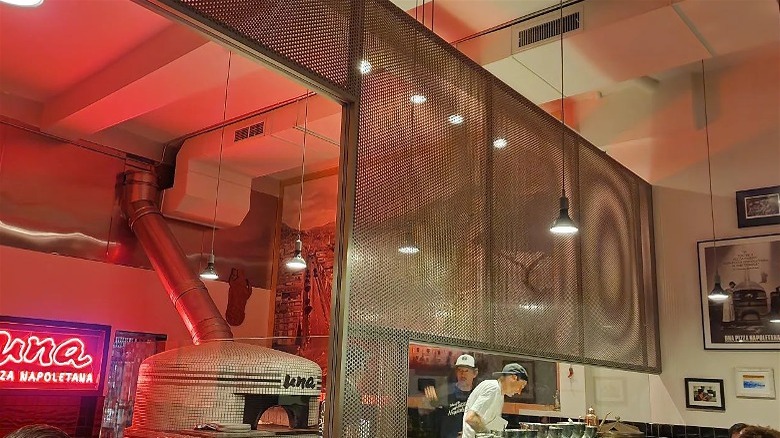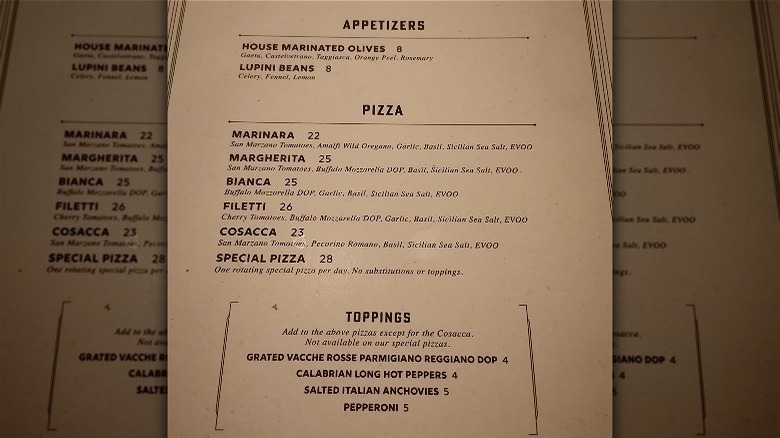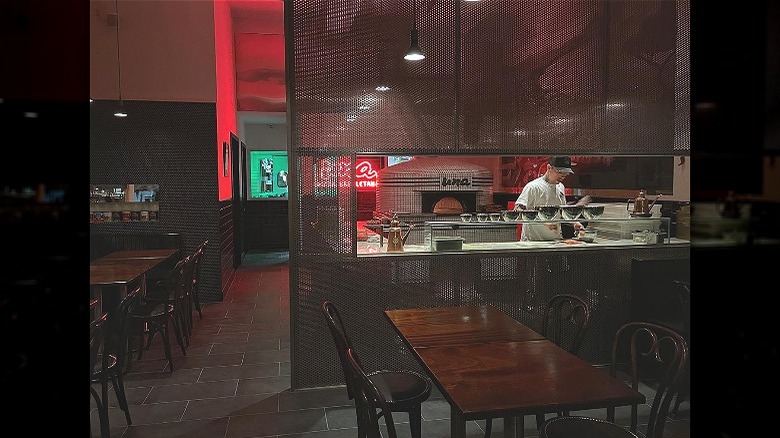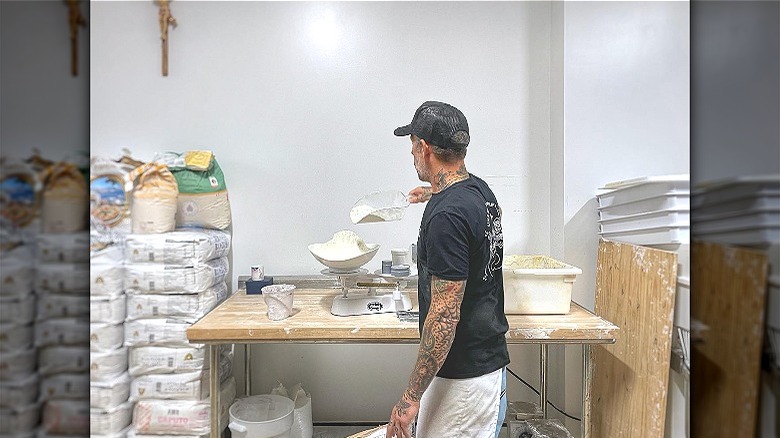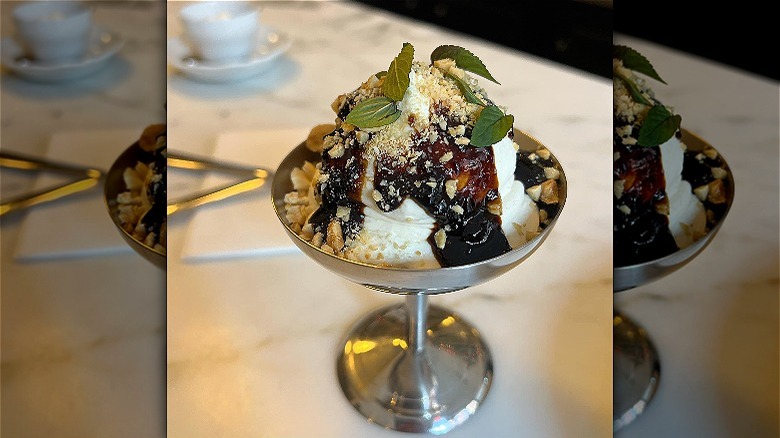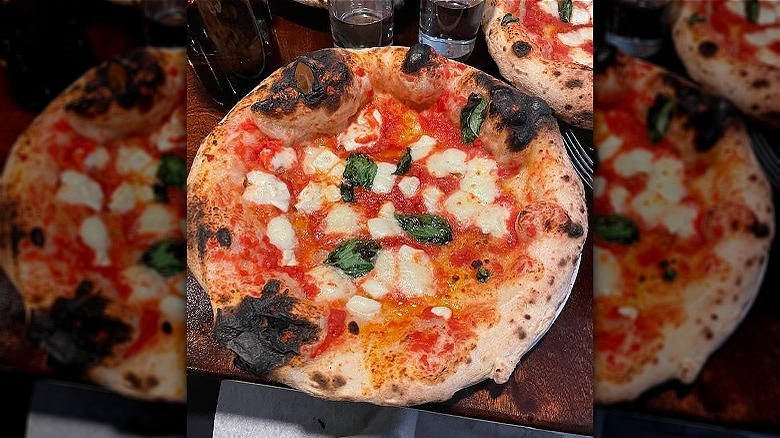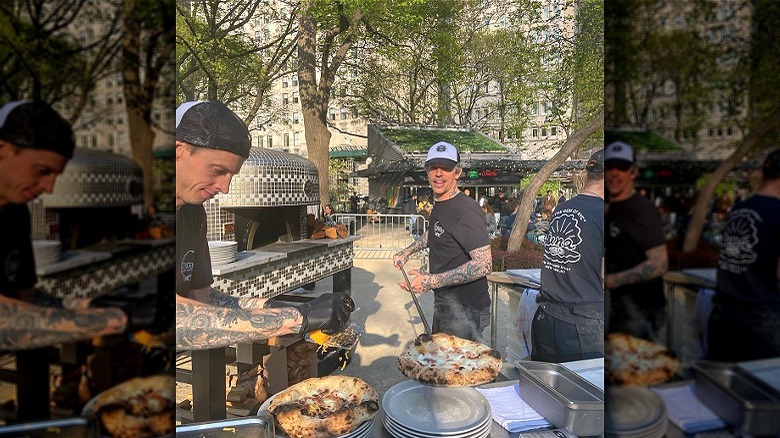Una Pizza Napoletana: 13 Facts About The Restaurant That Serves NYC's Best Pizza
New Yorkers are famously flush with pizza. There's no area within the five boroughs where you can't get the staple by the slice or as whole pies on the regular. But the city's claim to fame comes with none of the Big Apple stereotypes — no takeout, no delivery — and it's a cut above the rest. Anthony Mangieri has tirelessly perfected the craft of wood-fired pizza at Una Pizza Napoletana, the spot celebrated by the Michelin Guide and The New York Times for its high-quality, artisanal fare. And if you didn't think the hype could get any bigger, consider how industry authority 50 Top Pizza ranked it the planet's number-one pizzeria — tied, mind you, with a legitimate brick-oven joint from Italy.
The eatery's been around since 1996, and despite the various reinventions brought on by new locations and staff changes, Mangieri's heat-kissed pies continue to draw — and sometimes divide — customers from all over the world. If that's not the sign that you've made it, then we don't know what is. How did this East Coast pizzeria dominate the global competition? From the shores of New Jersey to the world's culinary stage, follow us as we explore the pizza joint's rise into an American icon.
1. Anthony Mangieri taught himself how to make pizza
The first aspect of understanding Una Pizza Napoletana is knowing the man behind the counter, Anthony Mangieri. While he was born and raised in New Jersey, his Italian heritage (Naples, specifically) drew him to the culinary traditions of his ancestors. His biggest fixation, of course, was pizza. In his youth, frequent trips to Italy exposed him to the craftsmen who made pies in large, fiery ovens the way they'd been done for centuries, and with assistance from relatives and artisans willing to share their secrets, he began his own pizza-making journey at the ripe age of 15.
Essentially, he taught himself how to make pizza using all of the information he could get his hands on, as well as lots and lots of practice. He had an insatiable appetite for learning, telling CBS Mornings about how he pestered his grandmother for details. Immersing himself in bread-baking in particular played an instrumental role. He explored many cookbooks on both Italian and French practices, and the techniques that went into crafting European-style loaves would go on to influence the crusts of his Neapolitan pizzas further down the road. Keep in mind all of this work occurred without any formal training or enrolling in culinary school.
2. Una Pizza Napoletana evolved out of a bread bakery
After equipping himself with the tools of the trade, Mangieri threw himself into his first baking venture. He sold artisanal bread out of a shop in Red Bank, New Jersey called Sant Arsenio Bakery, an enterprise that was fully self-run by the young craftsman. He was chauffeured by his mother five days a week to knead the dough, bake the loaves, and handle customers starting in the evening and working until the following afternoon.
As much as the business was a source of pride for Mangieri, the hard-scrabble experience produced little in the way of profit. Soon, Mangieri abandoned bread and decided to embrace pizza full-time. In 1996, three years after the bakery, he pursued a different business in a strip mall in Point Pleasant Beach. This time, it was a pizzeria with a simple name: Una Pizza Napoletana. The phrase is Italian for "a Neapolitan pizza," and it's an uncomplicated statement that perfectly reflects what's served to diners: Pizza done the Neapolitan way. "I wanted a name that just said what it is," he told Young & Foodish in 2023. "I wanted the name to mean something humble, but also beautiful."
3. Mangieri assembles the pizzas by hand
Between mixing up the dough and assembling the toppings, Mangieri's fingerprints are on every part of an Una Pizza Napoletana pie. It's been this way over the last two decades. The head chef does the bulk of the work building every pie for the oven. If you visit on any given evening, it's very likely that the person spooning on the sauce or plucking basil leaves for your Margherita is the founder himself.
Certainly, the eatery's gained enough attention in recent years to require hiring more folks to assist behind the counter — Resy confirmed in 2021 that there were three people total in the kitchen, and prior to that employees from other renowned pizzerias like Roberta's joined Mangieri's operation. But at the end of the day, it's hard to dispute that Una Pizza Napoletana is somewhat of a solo operation, and the over 700,000 pizzas Mangieri has concocted in his time speaks to that. Anybody who can claim to have made more than half a million pizzas probably deserves a little bit of credit, do they not?
4. The dough is made without yeast
When it comes to a pillowy pizza, it's all about the yeast. But Una Pizza Napoletana doesn't use any in its dough, and that fact can be a bit of a brain-melter. If there's no yeast, how does the crust puff up with those wonderful bubbles during baking? The answer to that is natural fermentation. Instead of relying on packaged yeast to gobble up the sugars in the raw dough, the pizzeria leavens its dough with a starter that incorporates natural yeast from the environment. This process is commonly referred to as "natural leavening," and it's similar to what you'd find in sourdough bread.
There are a few benefits to making pizza dough in this fashion. The rise (about one day long) is fairly irregular, which means the rustic-ness of the pie comes out in full force — it's left to the whims of weather and climate to dictate its form. Another bonus is health-related. The long fermentation makes a product that ends up being easier for the stomach to break down (via Nutrients). In other words, your gut will have an easier time digesting it. Adding in that the dough is mixed on-site and never stored in the fridge, the final product — made only of flour, water, and coarse salt — transforms into a gloriously puffy crust.
5. Most of the ingredients are shipped from Italy
Having established the authentic flair of Una Pizza Napoletana's dough, it's easy to suspect this level of care goes into the toppings as well, right? You would be correct. The ingredients, by and large, are sourced straight from Italy, utilizing imported cheese, tomatoes, and flour produced by the region's artisans. Many of these ingredients have been used by the pizzeria going back to its Jersey boardwalk days.
Mangieri's dedication to crafting rustic pies deserving of the Neapolitan title has always been front-and-center at Una Pizza Napoletana. Canned San Marzano tomatoes, a traditional plum variety, are drained and squished manually to make the pizza's imperfectly pulpy sauce, while the buffalo mozzarella cheese hails from the Southern town of Campagna. The dough balls are made with flour from Caputo, a longtime Naples institution. Using premium ingredients, often shipped by plane on a weekly basis, has given these pies an undeniable allure.
6. The restaurant has resided in three different states
Lower Manhattan is where you'll currently find this Neapolitan destination (and a quick jaunt from Katz's Deli, no less) but it's not uncommon for Mangieri's pizzeria to switch up locales. Over the years, Una Pizza Napoletana has operated in New Jersey, New York (the East Village and Lower East Side), and San Francisco, traversing three states and hopping between coasts whenever the spirit guided it. For a 20-plus-year-old business, that's a pretty hectic timeline when put on paper.
Una Pizza Napoletana usually sticks to one storefront, and with the exception of balancing two brick-and-mortar in the Garden State and Big Apple up until 2021, this has always translated to boarding up the previous shop when departing for greener pastures. Despite fans' confusion (mixed with desperate yearning) whenever the shop bade farewell from a community, Mangieri is quick to show appreciation for the outpouring of love. When news came down of the Atlantic Highlands outpost's shuttering to shift focus to the New York location, the pizzeria's Instagram page expressed gratitude for its brief, albeit enriching, residency.
7. Una Pizza Napoletana is only open a few days every week
Whereas the average Big Apple pizza joint seems to feed customers on a 24/7 basis, Una Pizza Napoletana fires up the oven only three days a week. This is quite brief for any restaurant but when it comes to its business hours, the spot makes its own rules. In addition to following a slim schedule — currently Thursdays, Fridays, and Saturdays — the restaurant doesn't open until 5 p.m., meaning service is solely focused on dinner time. Mangieri has cited prioritizing family, along with the labor-intensive nature of the job, for the short window of availability.
What's more, Una Pizza Napoletana doesn't keep preparing ingredients as the night goes on. The establishment, by contrast, keeps a limited supply of dough, and this stock dictates how long the kitchen will remain open to orders. Theoretically, an entire batch could disappear within 90 minutes if there are enough hungry patrons in the room to devour them all. By that token, getting your hands on these wood-fired beauties will not exactly be a walk in the park compared to those dollar slices you can buy on every corner.
8. The menu is famously sparse
If you thought Una Pizza Napoletana's limited hours were minimalist, just wait until you see the pizzas coming down the pike. Deliciously simple in scope, the range of toppings is small for a pizzeria. Consisting of five pies total — Margherita, Marinara, Bianca, Filetti, and Cosacca — the selection is exceptionally austere even counting the weekly special. That also goes for the scant array of customizations visitors can add to their pizzas, like pepperoni and Calabrian peppers.
Maintaining a less-than-expansive selection is nothing new for the business —originally Mangieri only offered only two — yes, two — pizzas total when Una Pizza Napoletana first opened in New Jersey, so it's definitely been on the leaner side before. The combinations, which focus primarily on the Neapolitan tradition, tend to stick to classic combinations, with cheese, tomato, and herbs adorned differently depending on the particular type. Part of this stems from Mangieri's philosophy of letting premium ingredients shine on their own without excessiveness getting in the way. Perhaps a handful of combinations doesn't satisfy the craving for variety, but the balanced flavors that are brought together remain dazzling all the same.
9. Tables can be hard to get at Una Pizza Napoletana
Being that Una Pizza Napoletana rejects takeout, dining in is your only option here. Yet even if you reach 175 Orchard Street with a second to spare, punctuality won't be enough to savor a taste — that's going to require a reservation. This is also where things start getting fussy. Guests can request their spots up to two weeks ahead of visiting when the eatery makes spots available. Booking a table for one of the nation's hottest pie joints gets pretty competitive, pretty fast.
Despite claiming on the website that walk-in service is offered, plenty of diners urge against taking the risk. Without a reservation, as Yelp reviews demonstrate, it isn't unheard of for groups arriving on a whim to get the boot because of a full dining room that's booked to capacity. Additionally, an empty table or two during a slower shift also doesn't guarantee an in either. According to one individual's experience, staff still turned them away because there weren't enough ingredients on hand to feed surprise visitors. Essentially, Una Pizza Napoletana is not the place for impromptu pizza — for that, you'll need to go elsewhere.
10. Una Pizza Napoletana's perfectionist approach has garnered praise — and criticism
You would be wise to call Anthony Mangieri a professional chef, but his dogged dedication to crafting true Neapolitan pies puts him on par with something bigger — an artisan. What other restauranteur has inspired the nickname Pizza Pope to describe his mastery? At the same time, not everybody's been bitten by the hype bug with Una Pizza Napoletana. Where admirers go wild over the authenticity, detractors find the intense perfectionism baked into the pies exhausting and not worthy of the mass hysteria.
This split in public opinion is evident not just by food critics, but by regular diners who've reported on their experience eating at the famed pizzeria. What are some of the most frequent complaints? On Yelp, many naysayers bashed the restaurant's inflexibility towards the pizza's presentation and its perceived holier-than-thou attitude. Due to the emphasis on "real" pizza, patrons have regularly encountered pushback when requesting additional toppings for their pies, while others bemoan the price tag that, for a single pie gone within a few bites, seems a little extreme. "Pizza is good but not worth $25 for such a small size," one individual revealed. "I left still hungry after a $100+ bill."
11. Breakfast is offered on Saturday mornings
Believe it or not, the smell of wood-fired perfection isn't the only thing drawing foot traffic to Una Pizza Napoletana. On Saturday mornings, you'll find that the beloved pizza place retires the oven and transforms into a cozy little coffeehouse. Caffe Napoletana, as it's called, puts a spin on the cafe staples common to Bel Paese, switching out the savory fare for sweet snack cakes and shots of authentic espresso Manhattanites can sample until the early afternoon.
Breakfast is definitely far from our minds when imagining potential twists a red sauce joint can throw our way, but the zeal with which Mangieri attacks his experiments shows this is a natural progression for the business. Time Out writes that every dish is hand-crafted with ingredients one would find in a real-deal Italian coffeeshop (think Naples-grown apricots) as well as traditional bites like panettone, a sweetened bread loaf speckled with raisins. And if you're wondering where the hand-made doughs are, look no further than the sandwiches using homemade sourdough bread, courtesy of the head chef himself.
12. The restaurant gave rise to Neapolitan pizza across the U.S.
Today, America loves a good brick-oven pie. Major chains and indie pizzerias alike serve charred rounds of dough, and arguably, Una Pizza Napoletana blazed the trail for this style to take off. Esquire credits the restaurant for raising the delicacy's profile tremendously during the early 2000s, and it's not wrong. Mangieri told Eater that in the United States, "no pizza makers were doing" what he was doing.
In the grand scheme of things, Neapolitan pizza is nothing new, of course. The city of Naples is celebrated worldwide for this culinary contribution, and being highly protective of its centuries-long practice means there are protocols to follow in order to gain the Verra Pizza Napoletana label. However, when Mangieri was coming of age in New Jersey, the dominant variety proffered around him — and the East Coast generally — looked nothing like the billowy circles topped sparingly and eaten not by the slice, but with silverware. Without its pioneering vision, who's to say we'd have Neapolitan-style pizzerias selling wood-fired bliss to the masses today?
13. The pizzeria partnered up with Shake Shack
You might expect Una Pizza Napoletana to team up with, say, another pizzeria or fellow ristorante for a special collaboration. But the restaurant keeps us on our toes. In addition to concocting flavors with New York creamery Morgenstern's, Una Pizza Napoletana shook up its menu for a one-off collaboration with Shake Shack, a burger chain that's renowned in NYC and beyond.
The partnership took place at Madison Square Park in spring 2022, where for two nights diners were able to indulge in dishes fusing the strengths of both eateries. One of the most notable offerings in the spread was a wood-fired pie riffing off of the SmokeShack Burger, the franchise's signature sandwich featuring many of the same toppings — such as chopped bacon, cherry peppers, and tangy Shack Sauce — on a Neapolitan crust. Although far costlier than what an average burger and fries would go for at $75 a pop, the whole soiree had it all — Italian-style creamy custard, fine wines, and panoramic skyline views to enjoy while dining al fresco.
